A balloon, a circus, 2 pubs and a wizard.
It was the week before Halloween, a day of brief rays of sunshine punctuated by heavy downfalls of rain. I was on my way to find two pubs 1/3 of a mile apart on the Burnley road ten minutes walk from the centre of Todmorden just across the River Calder from Centre Vale Park. Centre Vale House, an imposing residence with gardens, stableblock, coach house, and outhouses was built in 1821 for Thomas Ramsbotham a cotton manufacturer from Manchester who owned the water powered Ewood Mill where dimity and fustian was made.
Centre Vale House subsequently became the home of John Fielden, MP for Oldham and his descendants. His most notable campaign as an MP led to the Ten Hours Act of 1847, which limited women’s work to ten hours a day and inevitably, due to the division of labour, also reduced men’s and children’s working day. He wrote “I well remember being set to work in my father’s mill when I was little more than ten years old. Of my associates then only a few of them are now alive; some dying very young; others living to become men and women; but many of those who lived have died off before they attained the age of fifty having the appearance of being much older, a premature appearance of age which I verily believe was caused by the nature of the employment in which they were brought up.”
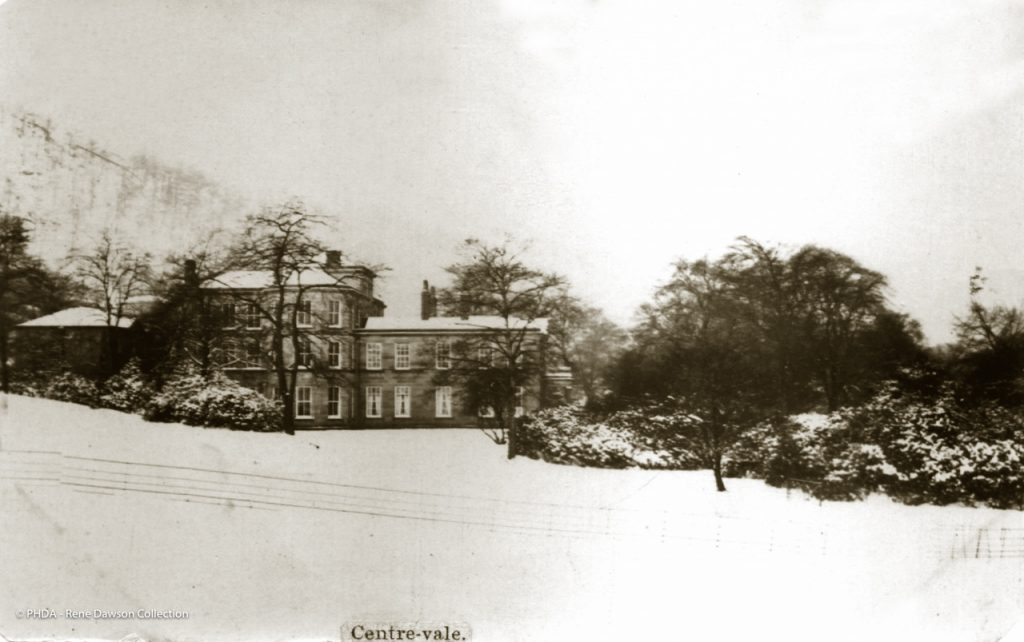
The property stayed in the Fielden family until 1910 when it was sold to the Borough council and opened as a spacious public park of 75 acres in 1912. During the first world war the house served as a temporary hospital for wounded and convalescent soldiers in 1914, a fitting tribute to a family who were such great benefactors to the town, both in the erection of public buildings but also in the care and concern they had for the mill workers of the town. I looked in vain for the house but by 1947 dry rot had set in and sadly the building was demolished in 1953. But I did find the statue of John Fielden, created in 1869. He was known as Honest John. Hmm. My writing group meets in a pub in the centre of Todmorden called Honest John. I always wondered to whom it referred! It’s just across the road from the imposing Town Hall which was built with money donated by his three sons and is the most well known and visually arresting of the works carried on by this philanthropic family devoted to the betterment of Todmorden. Other works which he funded including improving the town’s drainage, the construction of a town workhouse, housing for workers, and the building of the Unitarian Church.
Five years after Centre Vale House was built one of my ancestors, Thomas Ingham, became landlord of the Shoulder of Mutton at just 23 years of age. The pub is one of the oldest establishments in the area dating back to the 1600s and originally incorporated a farm, a slaughterhouse and a brewery and like many pubs it is recorded that, in 1817, it also housed a library. For over 75 years the Ingham family, first Thomas Ingham, then his son William and finally his grand daughter Ann ran the pub: In the Todmorden Almanac I found that ’Mr Thos. Ingham commenced selling drink at the Shoulder of Mutton Inn, Toad Carr, Dec 12, 1826. So, it was to this pub that I was bound. Following the perimeter of Centre Vale Park I almost walked straight past my destination because it’s been renamed.
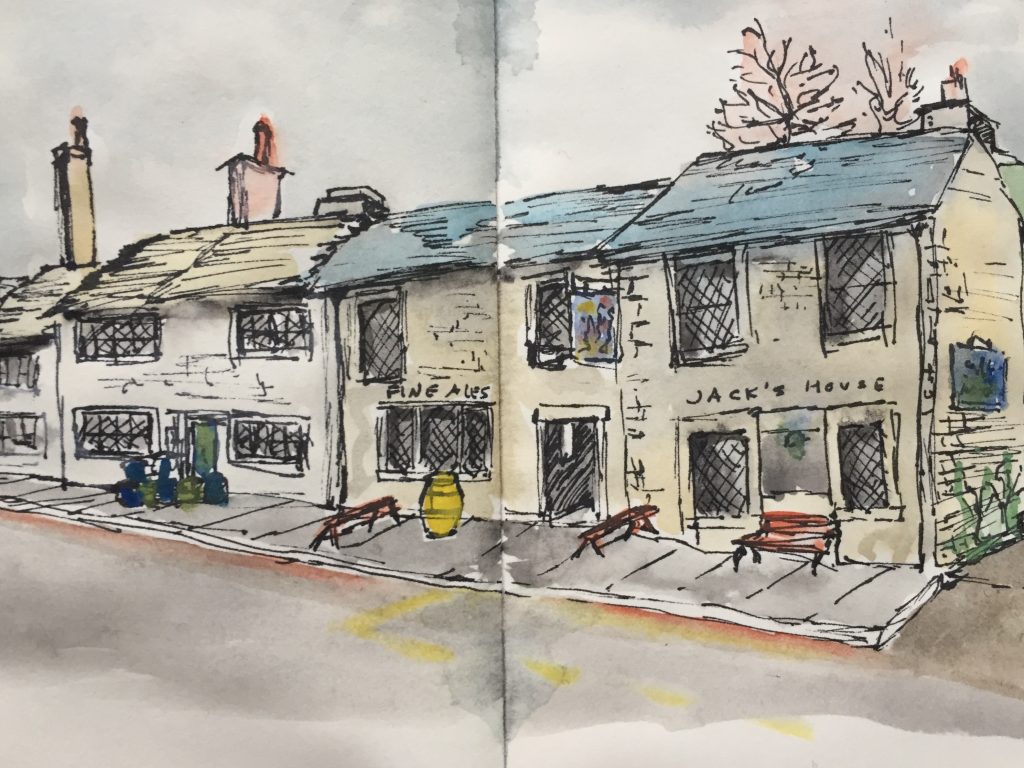
It’s now Jack’s House, a name it adopted when it was refurbished by one Jack Brook in 1974. I’d read that in 2014 it had been awarded Pub of the Week by the Lancashire Telegraph and I’d called the pub in the morning to make sure it would be open. I found only one other table occupied. Inside it was an interesting mixture of ancient and modern. It’s got a good reputation for live music but this morning a big screen TV was showing some reality daytime show while slot machines lay dormant along the walls. These up to date furnishings were housed in a cosy lounge, with wood floors, exposed stone walls some coated in rough plaster, open fireplaces and a low beamed ceiling. In one corner a few guitars hung on the wall, available to anyone who wants to have a strum. Small latticed leaded windows looked out onto the park and old pictures of the town were displayed on the uneven walls. The tiny snug room has a stone, barrel-vaulted ceiling inches above my head. Many years ago the local bobby, Sergeant John Heap, lived next door and found ‘the hold’ most convenient to house the area’s rascals while they awaited judgement from the travelling magistrate. Today it’s strewn with fairy lights but its stones are bulging with history.
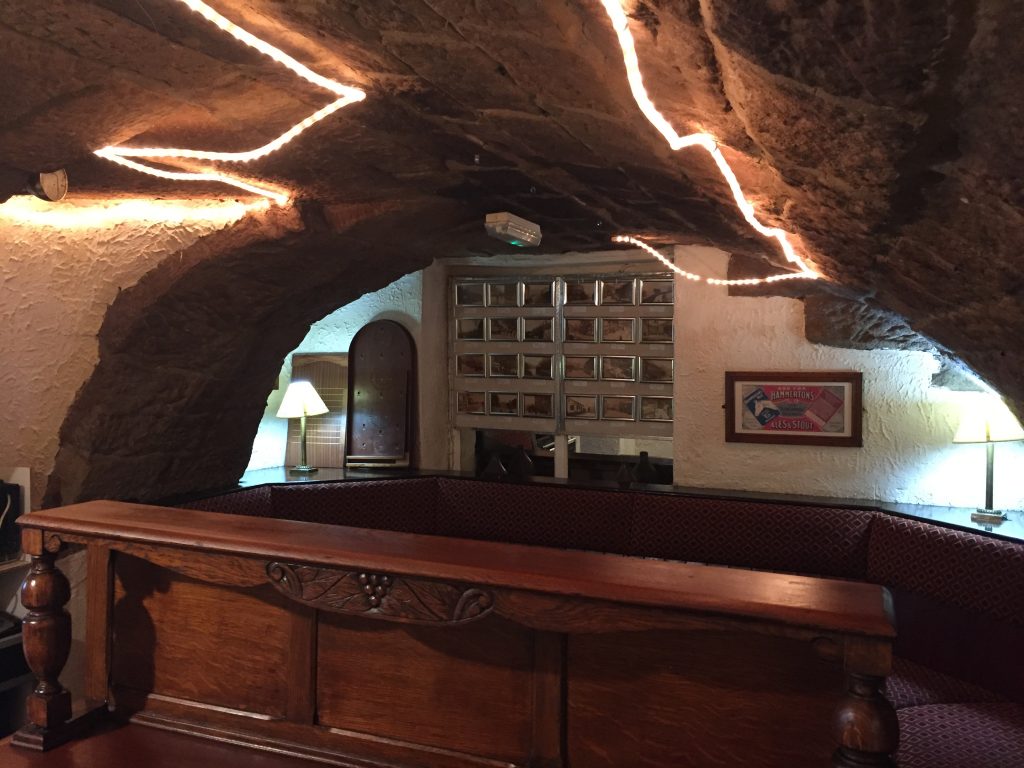
Barrel vaulted snug 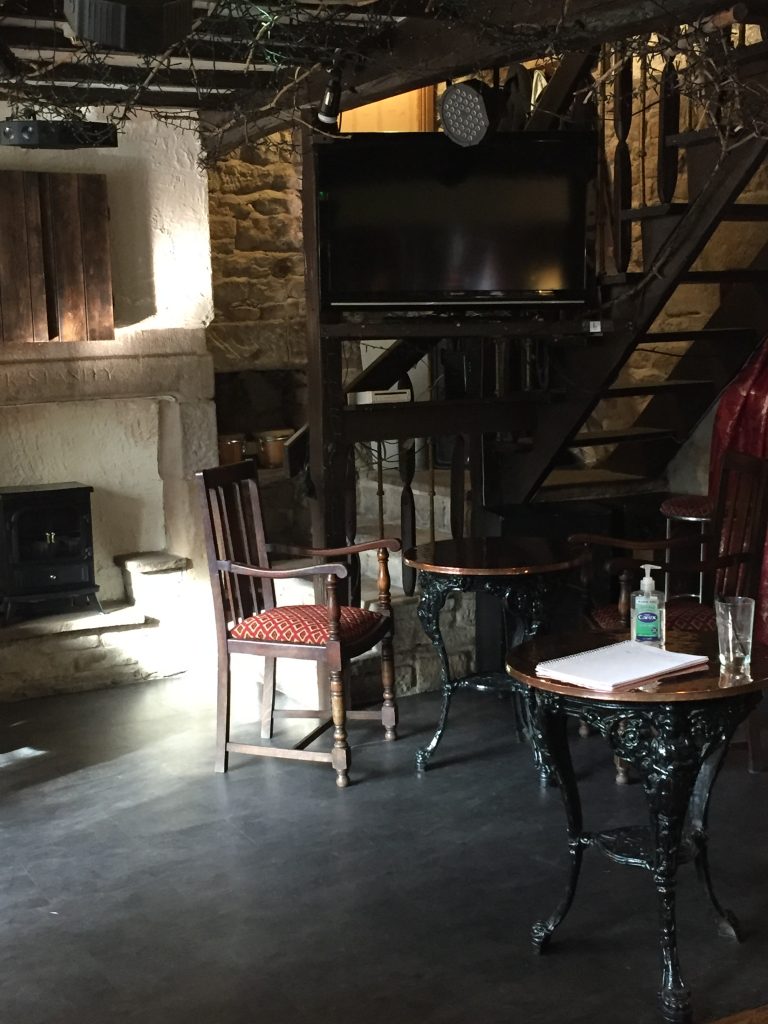
Olde worlde
So this was the pub that remained in the Ingham family from 1826-1910, Thomas’s daughters Ann and Ellen eventually taking over the tenancy from their father. I took a seat in the ‘new bit’ (added in the 1700s) where Bella the pub pooch was lying on her bed in front of the fire as I chatted with the family that make Jack’s Place their home today. Landlady Sue was eager to share her knowledge about the building itself and how the building and rebuilding of the Burnley Road directly outside the front has impacted the place. As the road has gradually been rebuilt its got higher and higher so now the pub floor is below the road level making it subject to flooding, a constant problem in the Calder Valley.
It was here that William was born in 1827, the eldest of 4 children born to Thomas, the innkeeper and his wife Sally.
By the age of 24 William was a butcher, still living here with his family, in the rooms above the inn. In 1858 he married Hannah Gibson, and it is through her that I trace my connection to the Inghams. Hannah’s father had been the butcher and innkeeper of The Bull Inn in Hebden Bridge until he killed himself in his slaughter house just 2 months after Hannah’s marriage. I found that she had been baptized at St James’s in Hebden Bridge by Sutcliffe Sowden who had presided at both the marriage and funeral of Charlotte Bronte.
Exactly 14 days after William and Hannah were married at Halifax minster their first child was born, a daughter, Sarah Ann, the first of 6 children. Their wedding took place on the 3rd of March. I wonder what the weather was like. There could easily have been snow on the ground as they travelled the 12 miles to Halifax. Surely they must have travelled by horse and cart. They would have taken the turnpike road through Hebden Bridge. William and Hannah set up home in Blind Lane, about two minutes walk from the pub, where William kept a butcher’s shop.
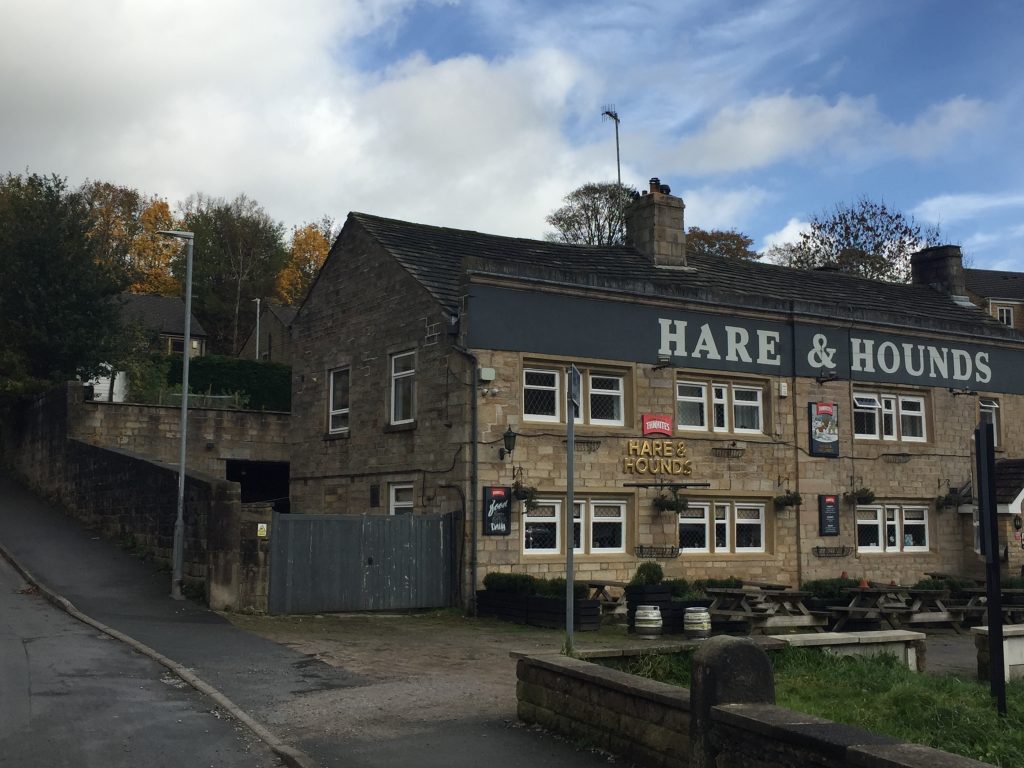
Then, by 1870, William 43 and Hannah 34 were following in their parents’ footsteps and were innkeepers at The Hare and Hounds , just five minutes walk away up Burnley Road. There they had six children. I read that ‘A cow in the possession of William Ingham of the Hare and Hounds Inn near Todmorden began frisking at Hartley Royd and thereby threw itself on its head and broke its borns and its neck. It was immediately slaughtered. The cow was worth $19.’ In another incident recorded in the Todmorden Almanack in 1877 Mr George Ormerod aged 63 ‘fell on the floor of the Hare and Hounds and died the same night. Three of his ribs were broken. A verdict of ‘Death through misadventure’ was given. My sense of the macabre put a spring in my step as I followed the channelled River Calder along the perimeter of Centre Vale Park to the Hare and Hounds. I’d called in there once before I knew the details of its connection with my family. A large car park fronts the old stone building on this rare piece of flat land. I couldn’t help but smile at the Strictly No Ball Games notice, for this was once the home of a bowling green I am reliably informed from someone on the Todmorden Past and Present Facebook page.
Like the Shoulder of Mutton the inn dates back to the 17th century and still retains many of its original features. I’m sure William and Hannah would have felt quite at home here. Today at the rear of the building a beer garden backs on to the railway embankment but originally this was the home of the kennels housing the hounds of the Todmorden hunt. It must have been a noisy place to live but it would appear that William was a member of the hunt himself for it is said that William’s favourite hunting horse was buried in that embankment. The horse’s stirrups and bit were kept for many years at the pub. Today the door was open and only one other table was occupied, by the inn’s present family. The walls are full of old photos, one being of a charabanc filled with Todmorden landladies on their way to their annual picnic. I asked the current landlady if she knew anything about William’s horse. “The inside of the pub was covered in horse brasses when we moved in but the brewery took them all down and carted them away.” I was disappointed. “What about where William’s horse was reputed to have been buried?’ Well, the locals used to call the embankment at the back the pet cemetery. We’ve dug it out and came across a few bones, probably dogs, and lots of tyres, but we’ve made it into a beer garden now.” “Is there anything left of the kennels that belonged to the hunt?” I asked. “It’s just a big building where we keep our stuff. I’ll have my husband take you out there if you like.”
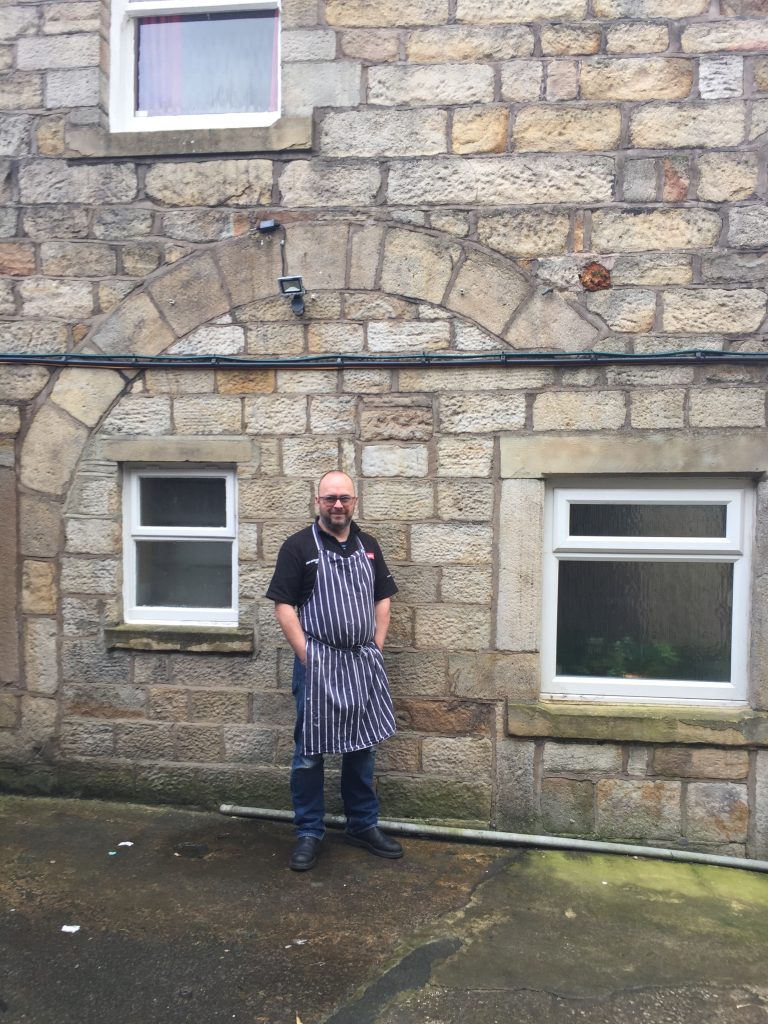
A few minutes later I found myself being beckoned through the big double doors to the left of the pub and into the family’s inner sanctum. The yard still has its old cobbles and in the rain today they were decidedly slippery. The landlord pointed out the original arched doorway in the pub building showing where it had once been an attached barn, and there, built into the embankment was a large low building that had once been the kennels.
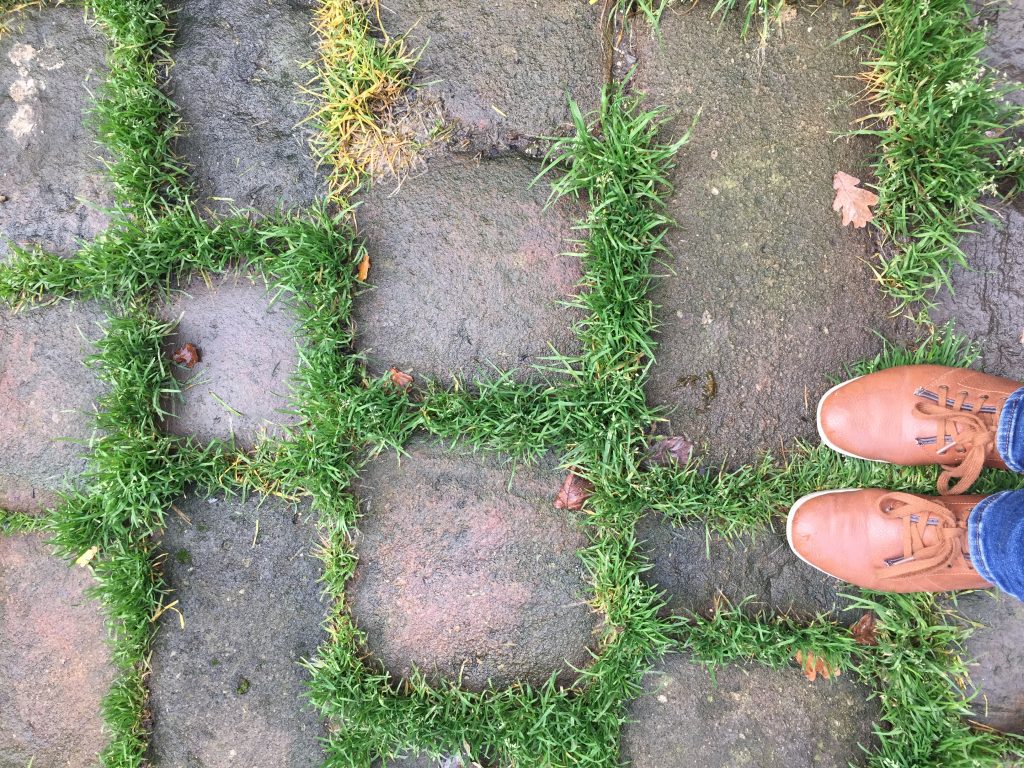
It’s very satisfying to have read about something and then finding that there are remnants of it that I can still see 200 years later, especially when it belonged to my relatives. High above the inn is the silhouette of Whirlaw, a rocky outcrop abounding in myths and legends. I’d taken a hike to that exposed spot in June 2016, with the same leader as the hike which led me to Dobroyd Castle.
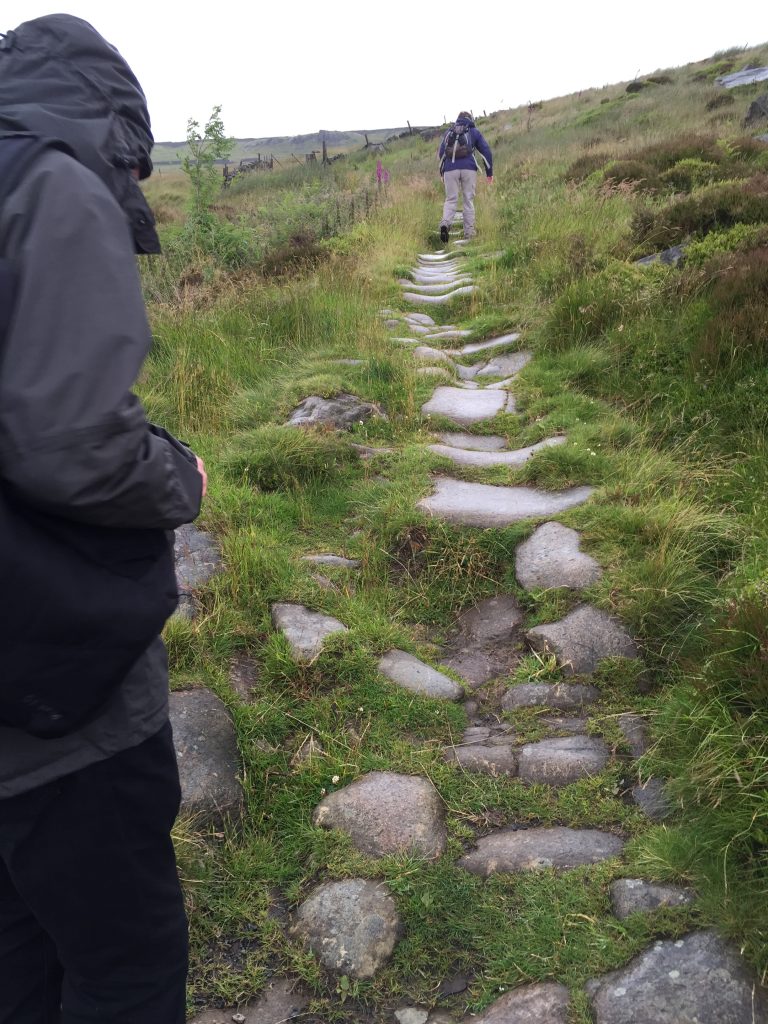
The path to Whirlaw, 2016 
Sheltering from the rain, 2016
Just as we reached the rocks on top of the hill a torrential rainstorm blew through the region and I have a photo of me cowering beneath the stones. I think we must have disturbed the Wizard. During lockdown I obtained a signed copy of ‘The Wizard of Whirlaw Stones’ by Todmorden author, traveller, broadcaster, man extraordinaire, Billy Holt and on one of my hikes I just happened to stumble on the grave of his beloved horse Trigger on whose back he rode to Italy and back.
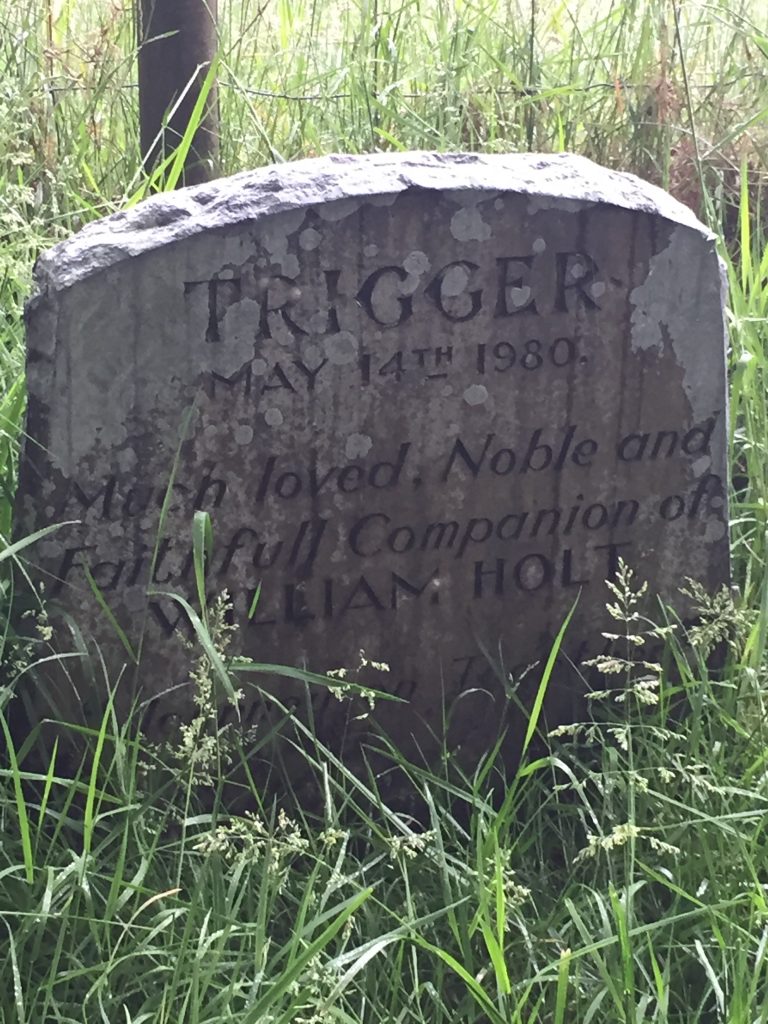
As I left the Hare and Hounds I thought about the Todmorden hunt who housed their dogs in that building, now used for general storage. In 1883 the first in a series of farmer’s dinners given by gentlemen comprising the Todmorden hunt and a few friends came off at the Hare and Hounds. A company of about 50 farmers and others spent a most agreeable evening.’ Feb 1883. In 1886 the sale by auction of the famous Todmorden pack of harriers at the kennels adjoining the Hare and Hounds was mentioned in the town’s almanac: ‘The pack consists of 35 hounds realising 78 ½ guineas.’ In more recent times in 2018 the pub was the location for an Extraordinary Meeting of the Fielden Society, a group who wish to keep the history of the Todmorden part of the Fielden family intact for later generations to see. The meeting had been called to consider winding up the society due to the low level of support but I was pleased to learn that a new committee was elected and the society is still going strong.

In 1879 Hannah died and William retired and moved to 2 West Street with 6 children. He remained living there for the rest of his life and it was here that he died in 1901. I noticed that by this time William is 52 years old and on the census he is reported as ‘retired.’ That’s unheard of in my research. People just basically worked until they died. It’s also extremely old to be the father of a two year old daughter. Or was he?
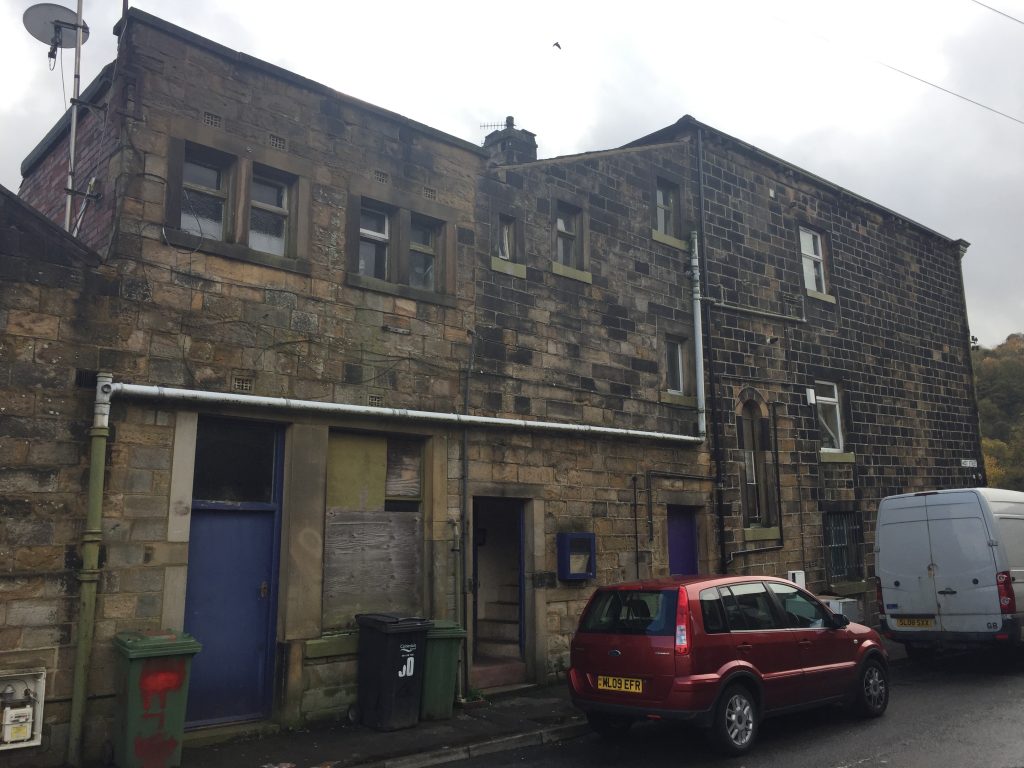
2 West Street 
West street is the side street
At first I thought that perhaps his wife had died in childbirth. She was, after all 44 years of age when Hannah Elizabeth was born. I did a little, actually a lot, more searching and finally I found the answer to the puzzle. On October 13, 1878 a baby, Hannah Elizabeth, had been baptized at Heptonstall church. She’d been born on June 13, and her mother was a spinster, Sarah Ann Ingham. What clinched the fact that I’d got the right Hannah Ingham is that her address is Gandy Bridge, Todmorden. When I looked up Gandy Bridge online the first photo to pop up was of the old tearoom at the corner of West Street, showing Harry King’s bread and grocery shop. So, William appears to have passed off his daughter’s child as his own, at least for the prying eyes of the census taker. Sarah Ann would have been 20 years old when her daughter was born and eleven years later at All Saints Church, Harley Wood, she married a joiner, John Scholfield, seven years her junior – again, quite unusual for that period.
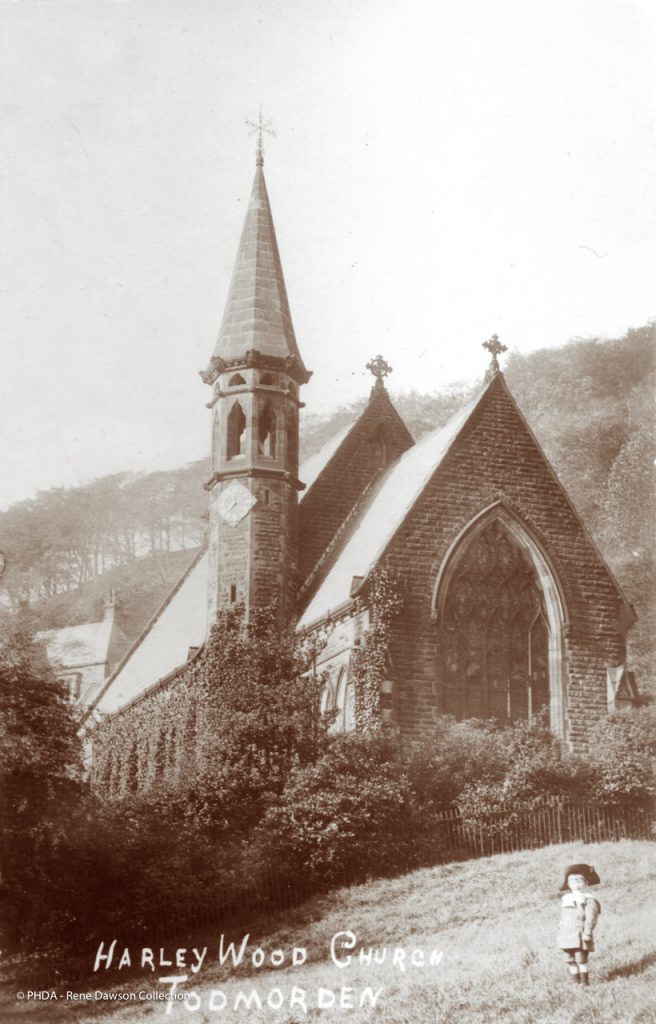
All Saints Church, Harley Wood, Lydgate opened 1858 and was demolished in 1975 following closure.
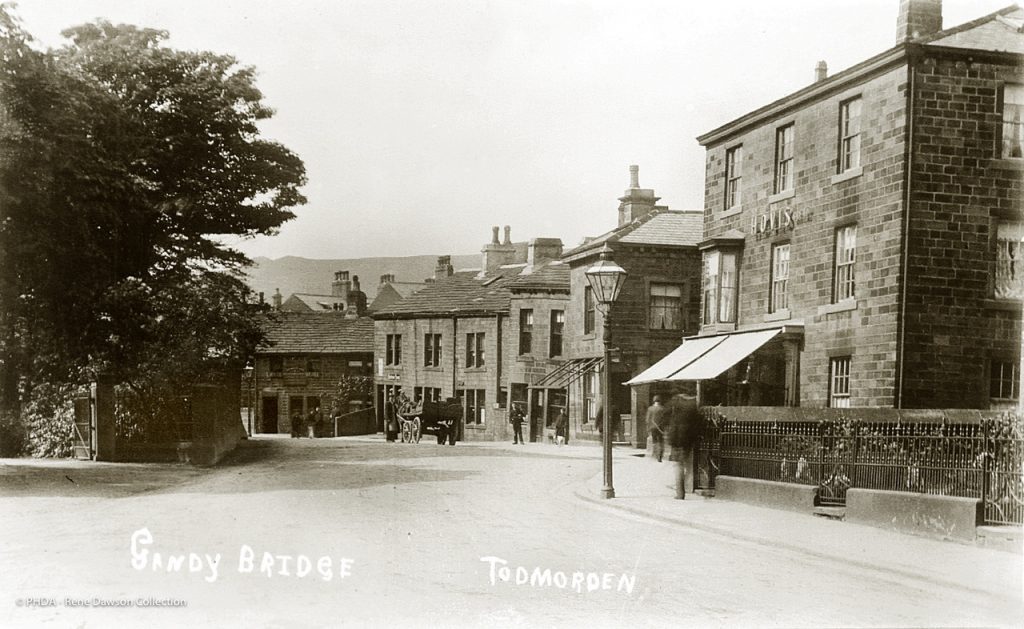
In a couple of minutes I arrived at 2 West Street. It’s a taxi business now, the first building on West Street off Burnley Road and the front of the building is Park End café, where remarkably I’d had lunch on the first organized hike that I’d done in Todmorden in 2016 when I spent the summer in Hebden Bridge. The highlight of the hike for me had been a visit to Dobroyd Castle, high on the hill above Centre Vale Park, built by John Fielden, the son of the John Fielden who had built Centre Vale House.
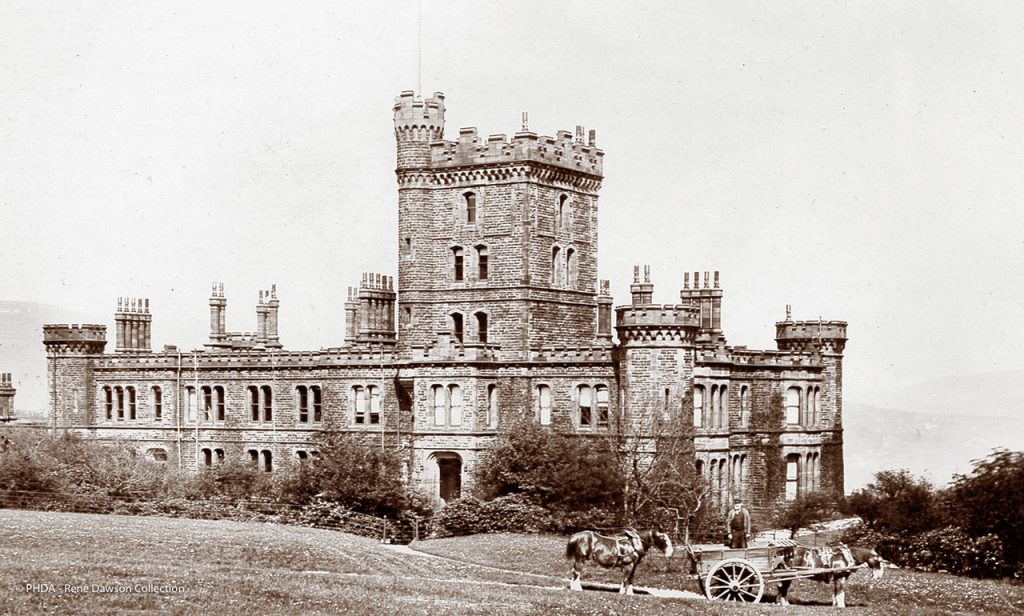
The castle has 66 rooms, 17 stables and cost 71 thousand pounds to build and the couple moved in in 1869. From my 2016 journal: ‘It’s now an outward bound school for kids from all over England. We passed a group of students from Wolverhampton. Our hike leader’s daughter had attended classes there only last week but Moy herself had never been inside. We knocked on the door and were told that because they are responsible for children they couldn’t let us in. I put on my best American accent and said that I’d “come all the way from California and would just looooove to see inside an English castle.” The door opened and we were able to step inside and look at the amazing statues, marble columns, intricate stone friezes, crystals chandeliers. A knight in full suit of armour stood guarding the staircase. Of course this ‘castle’ is a folly, but the opulence of the decoration was amazing.’
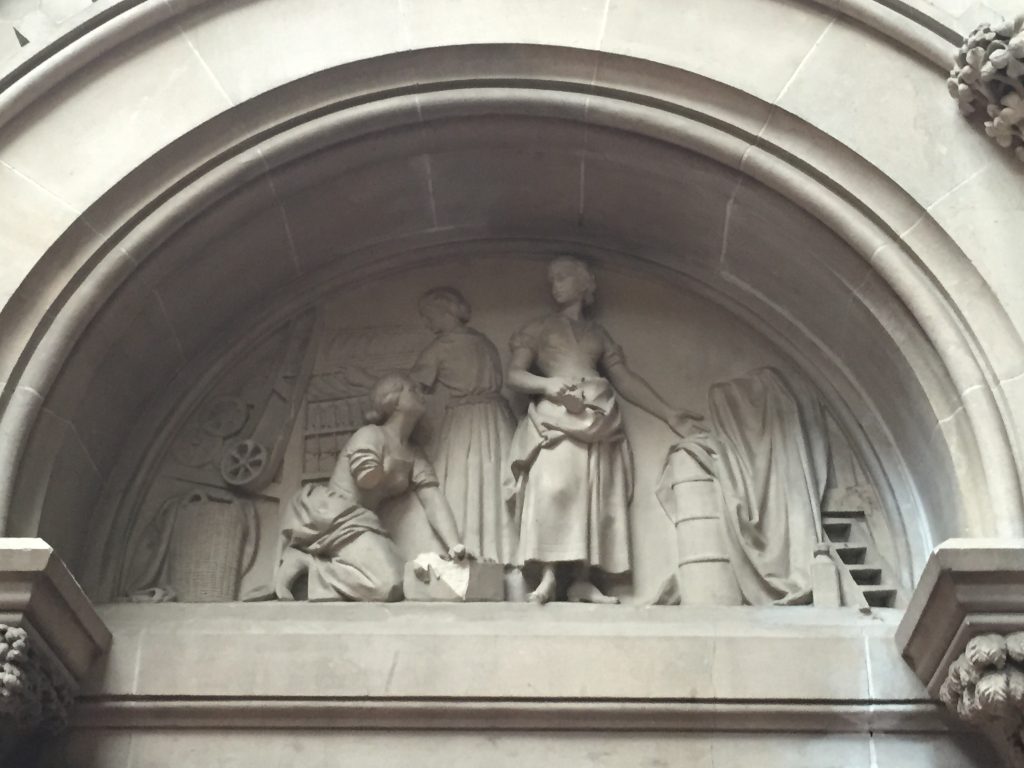
Inside Dobroyd Castle, 2016 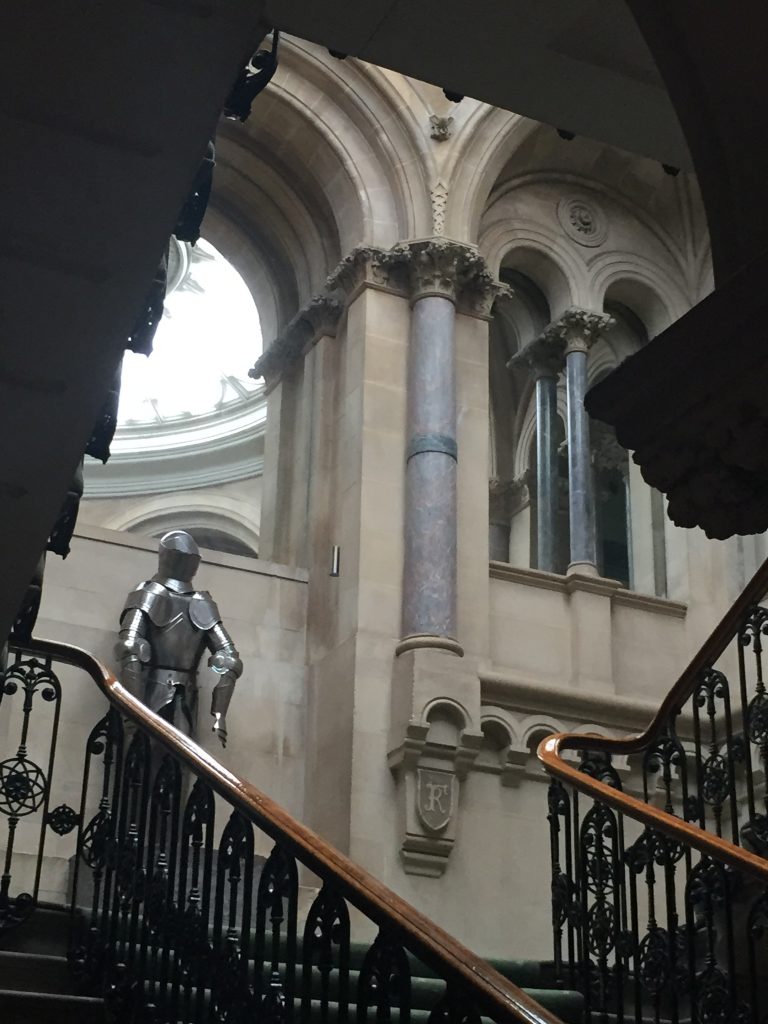
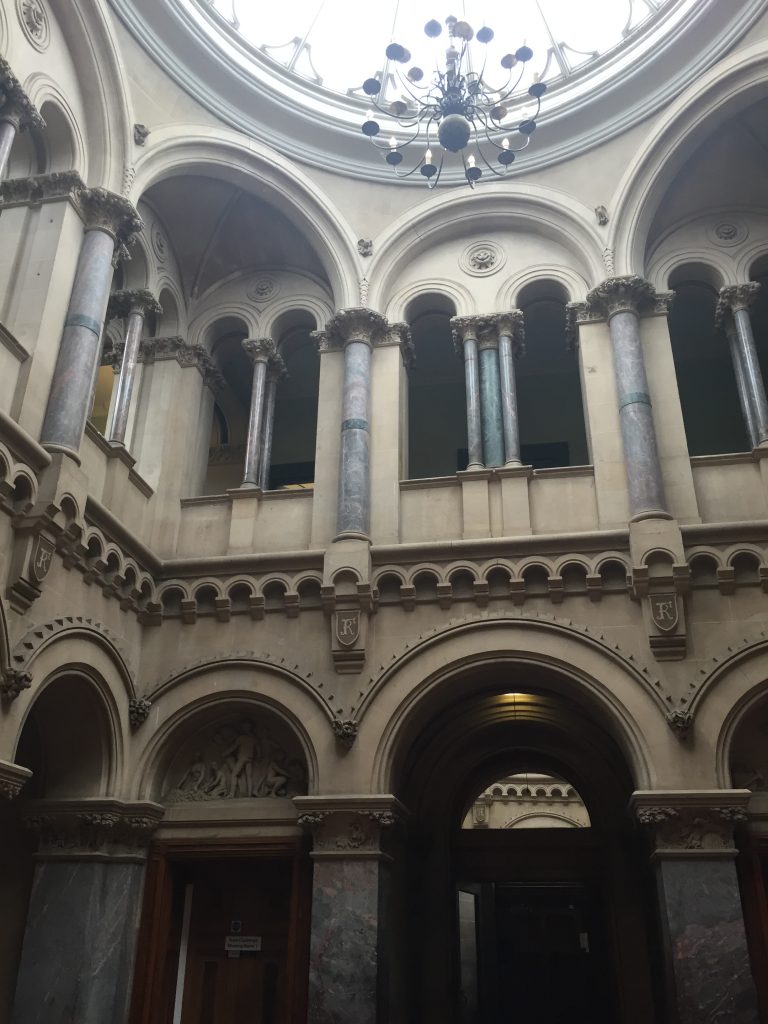
On Aug 21 and 22, 1891 an event occurred so close to West Street that it’s difficult to imagine William and his children, and his sisters Ann and Ellen who were running the Shoulder of Mutton not being caught up by the excitement. The children of the town had been given a half day off from school to participate in a grand parade and from Roomfield Board school in the centre of town the children marched in procession accompanied by the Todmorden brass band. They were heading to the large field adjacent to the Hare and Hounds for this was the 32nd annual exhibition of the Todmorden Floral and Horticultural Society, with both pony racing and human racing as well as an ‘unusually spacious marquee’ housing the flowers and vegetables to be judged. From the Todmorden newspaper account: ‘Friday was the better day of the two. There was no heavy rain in the afternoon though it came on smartly during the evening. Saturday proved very inclement from the outset; consequently the ground already pretty well saturated by the downfall of the previous night was speedily reduced to the conditions of a quagmire but the programme was stoically gone through as planned.’

Now it takes an awful lot of rain for people of the Calder Valley to complain about soggy conditions but here ‘unpropitious weather had a good deal to do with the paucity of attendance.’ Yet between two and three thousand children still attended over the course of the two days despite the inclement weather. Since moving back to England three years ago I’ve attended the Halifax county fair with its white coated, tweed capped judges, clipboard in hand making their decisions on the best cow, flower arrangement, and prize winning turkey with the gravest expression on their weather-beaten faces. One of my mum’s proudest moments was when she won ‘3 duck eggs, any colour’ in the local fair in Tottington. I still have her certificate, dating from the early 1960s. The newspaper account of the Todmorden show, taking up a whole page of the newspaper, duly listed the many categories and the names of the winners but it was what the winners won that fascinated me. I’m sure in my mum’s day you were just awarded a certificate. Back in 1891 the winner for a plate of tomatoes or a plate of peas was awarded 2/6, but for a bunch of grapes the winner was awarded a walking stick or pipe valued at 5 shillings. I tried, unsuccessfully, to imagine anyone in Todmorden successfully growing grapes and decided that such an achievement would be well worth a walking stick. The children’s sporting events featured a three legged race for boys, a 50 yard egg and spoon race for girls and an obstacle race for boys. My dad was a champion egg and spoon racer and I have a photo of him doing just that. The first prize for the obstacle race for boys under 18 was a six bottle dinner cruet and the second prize was a flower stand. Hmmm. I rather think it was their mums who were being thanked. For the 120 yard race the first placed winner won a tea and coffee service, the second won a six cup egg frame and spoons. One of the grandest prize of all was awarded to the winner of the 440 yard race: a buff leather Gladstone bag and the second placed winner came away with a China salad bowl and server. However on the Saturday ‘a number of the athletes decided not to compete when they saw the wretched state of the track owing to the heavy rain.’ On the horse track a pair of trousers and a vest was awarded to the winner of the carters’ race and the second placed winner got a whip! Perhaps he’ll come first next year if he uses it. The winner of the 2 mile pony race took home a black marble clock and the second placed winner had a handsome case of cutlery to share with his family. The sports concluded at about 6:30 and ‘then Miss DeVoy went up in a balloon and descended by parachute into a nearby field.’ Wow! That got my full attention. Dressed in a dark closefitting costume and light blue cap she climbed into the bucket suspended below the balloon and as she released the balloon from its moorings she rose almost vertically climbing to a high altitude but within a minute was lost from view ‘all the time rain pouring in torrents and streamed in bucketfuls as she ascended in the bucket.’ She was out of sight of the earth, somewhere around 7000-8000ft above the ground when she took the leap from the bucket. ‘In her descent she and the parachute swayed about like a pendulum.’ She landed in a field at Shurcrack and was conveyed back to the field in a trap, describing her experience has having been ‘half blinded by rain.’ ‘Large numbers (of people) had remained in the showfield while the hillsides and streets of the town and suburbs were dotted, in some places thronged, with knots of people watching for her ascent and descent. I’m sure the Inghams were there. This was her 34th jump and when finally safe on the ground she commented that today it had taken an ‘unusually long time before the parachute opened owing to its wet condition.’ What makes this jump so remarkable is that thirteen days earlier her husband, ‘Professor’ Higgins had been killed during a similar feat in Leeds. A tear had appeared in the balloon which caused it to trail against some telegraph wires, dislodging Higgins who fell 35 ft to his death.
But of course, there were no health and safety laws in those days that could have applied to this feat or that of the performers, both human and animal, who performed in Sanger’s circusan annual event also taking place in the field adjacent to the Hare and Hounds. A newspaper account reporting the circus says that in April 1894 ‘A few of the horses had been watering at the Hare and Hounds Inn when of the animals broke loose on returning to the field, and whilst galloping knocked four children down, injuring them rather seriously.’ Annals p137. Billed as ‘the grandest and most inspiring pageant ever witnessed by the eye of mortal man the procession covered two miles of oriental magnificence’ as it established itself on Holme Field Sanger’s circus consisted of a staff of 240 with 300 animals. The company travelled with its own blacksmith, wheelwright, tent makers, saddler and cooks.
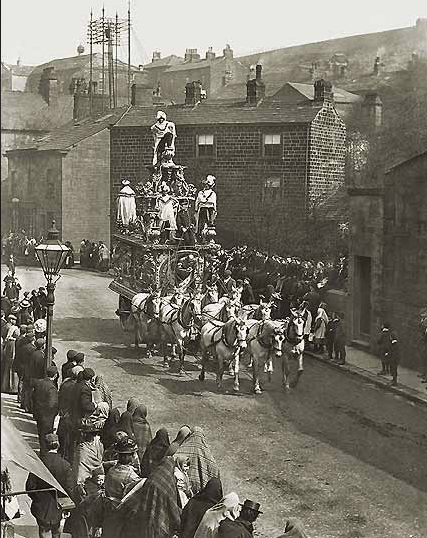
Two and four horse chariot teams headed the procession followed by monkey, ostrich and camel teams, ‘llamas driven by Natives, Western Wild and Prairie life with genuine Mexican rangers and Texas cowboys, a genuine camp of Cheyenne, Arapahoe, Sioux and Pawnees Indians,’ ten huge performing elephants, a band of musical elephants and pugilistic boxing elephants.’ 1905 Three big elephants ambled heavily along, displaying little apparent interest in their surroundings. Other features of the procession included an antiquated. uncomfortable-looking carriage, whites aim stated to have been the property of the late President Kruger. Another car, bearing high up on its top a lion, come very near to fulfilling the Biblical prophecy that the lion and the lamb shall lie down together, only in this case the lamb, which was in reality a full grown sheep, stood up all the way, separated from the king of beasts by only a couple of men. The lion, which was chained to the coach, ‘was a particularly fine specimen. with a grand head and mane. ‘John Sanger’s circus was billed as ‘The largest show in the entire world.’ It had even been bidden to Windsor Castle to perform for Her Majesty, Queen Victoria from whom John Sanger had received a diamond pendant.
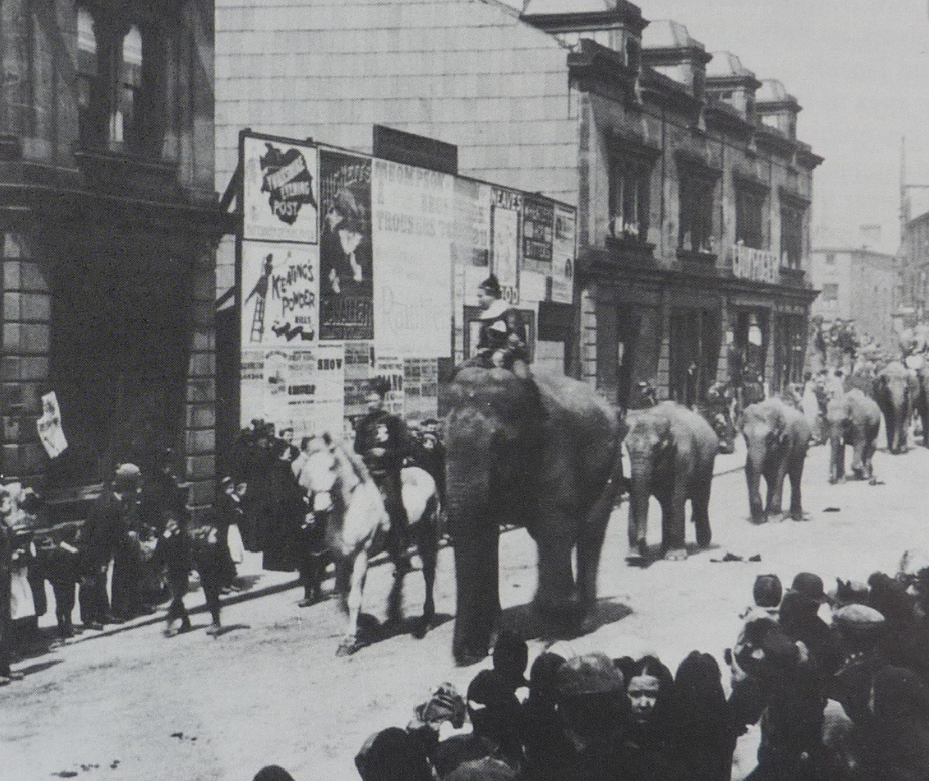
But in 1907 Holme Field was destined to become the new home, not of elephants and ostriches but an enormous spinning mill, Mons Mill. Building began in 1907 and it was completed in 1910, so Ann Ingham, Thomas’s daughter who was still at the pub when she died in 1910 would have witnesses its building. I wonder what she thought of such a huge building overshadowing the Hare and Hounds.
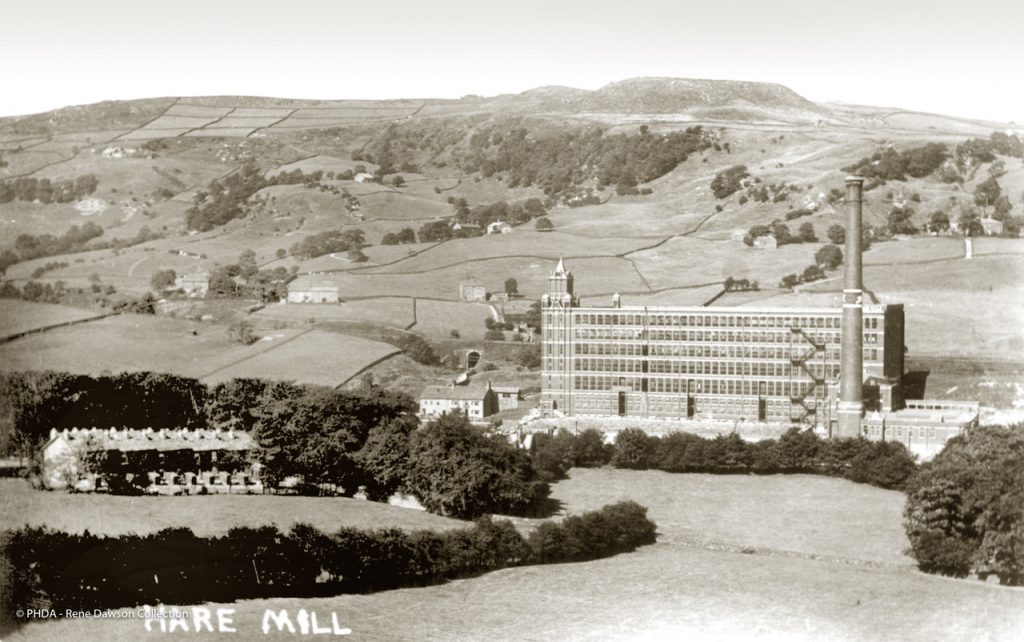
It was constructed of red Accrington brick, standing out like a sore thumb in this valley where stone is the ubiquitous building material, and was similar in design to that used in Lancashire cotton mills, causing the district in Todmorden where it stood to be nicknamed Little Oldham. My mum worked in such a spinning mill, Swan Lane mill, in Bolton and from my bedroom window at Affetside I could see many such mills spread across Bolton. It was anticipated that this new mill in Todmorden would provide work for 600 people and new housing for 400 workers was built consisting of several streets of terraced brick millworkers houses, which I could still see today on the left of the old stone inn.
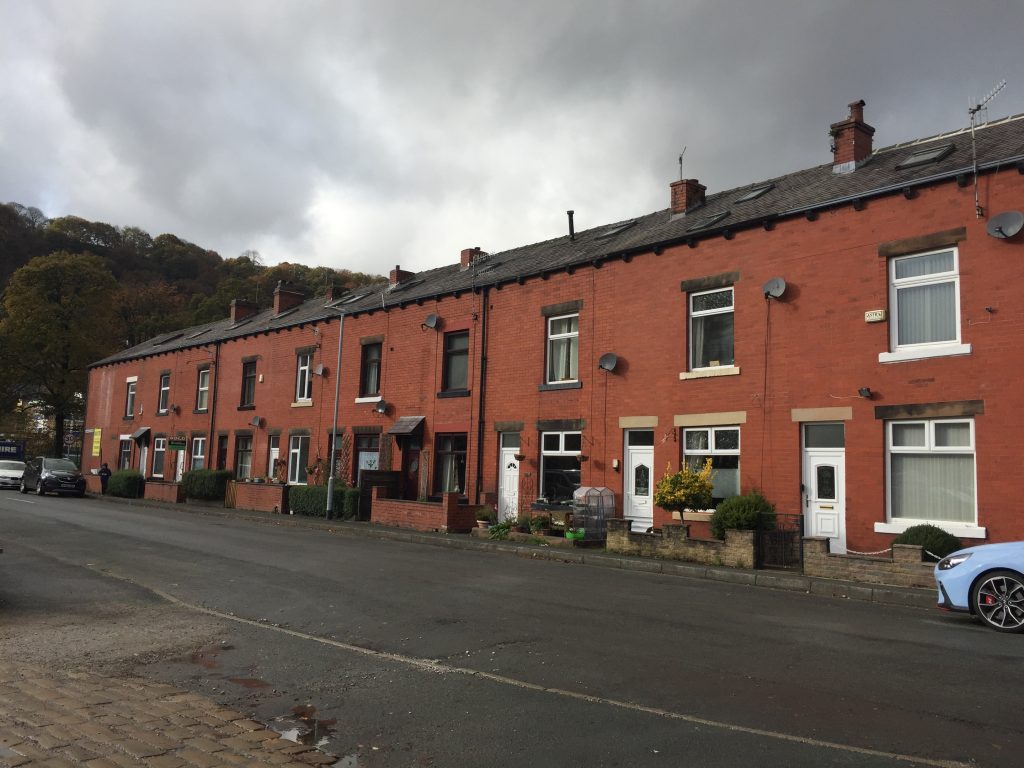
The mill was seven storeys tall and it was famous for the logo of a white hare on the mill chimney. There were six directors of the company and one just happened to be Frederick Hague Moss, another of my ancestors who owned a dye works at Bridgeroyd on the East side of Todmorden. The mill and its chimney were demolished in 2000 and the site is now a grassy bank on which is Asquith Hall, a residential care home and blocks of apartments.

As I walked back towards the bus station a photograph in an estate agent’s window caught my attention. Alongside the usual glossy photos of properties for sale was an old photo of three horse drawn carts, emblazoned with ‘King, borough bakery, Todmorden.’ On the back of horse number two rides a young boy, maybe five years of age bedecked in his little Lord Fauntleroy suit for a photograph was a special occasion.
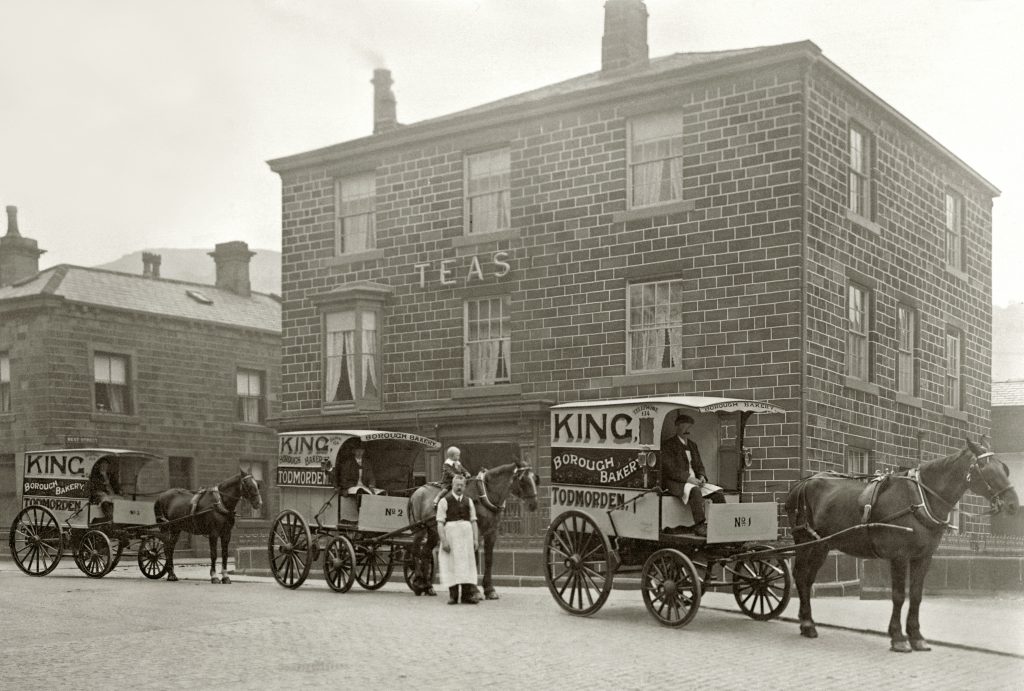
They were posing outside a three storey building with a sign ‘Teas’ high up on the wall. I immediately recognised the street at the side of the building – West Street – and I could just make out the street sign confirming my suspicion. There was no credit given on the photo but on enquiring in the office I was told it had come from the photo collection of Roger Birches. I found the collection online and within hours his son had emailed me a high resolution copy of the photograph but probably dates from around the turn of the century.

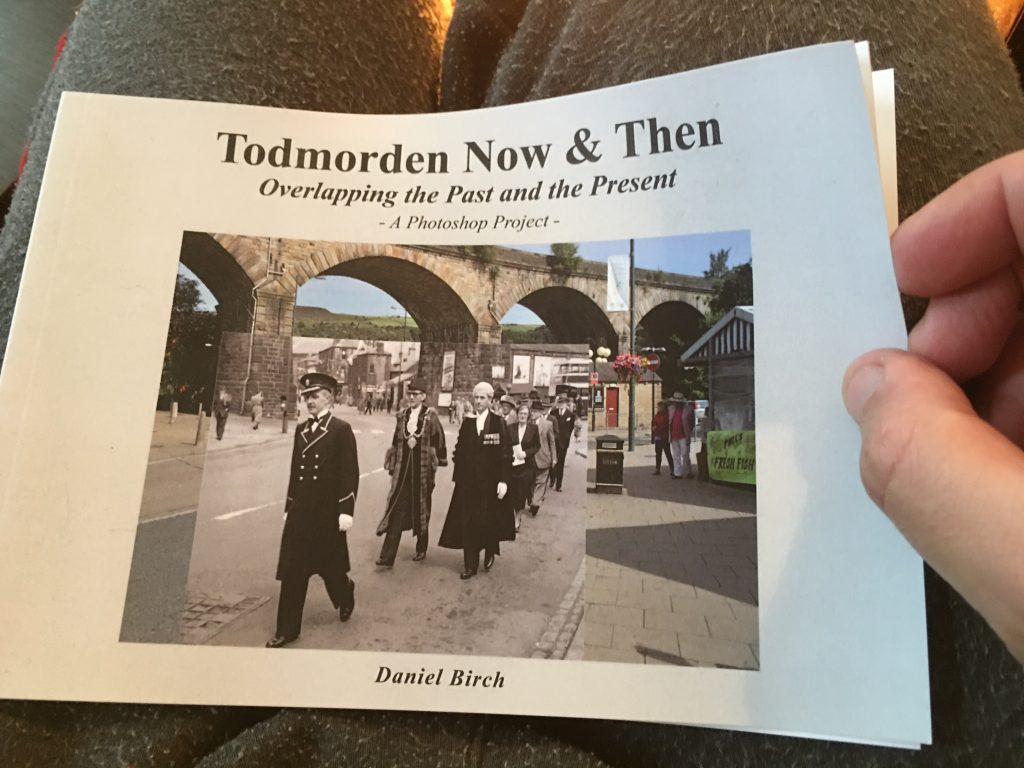
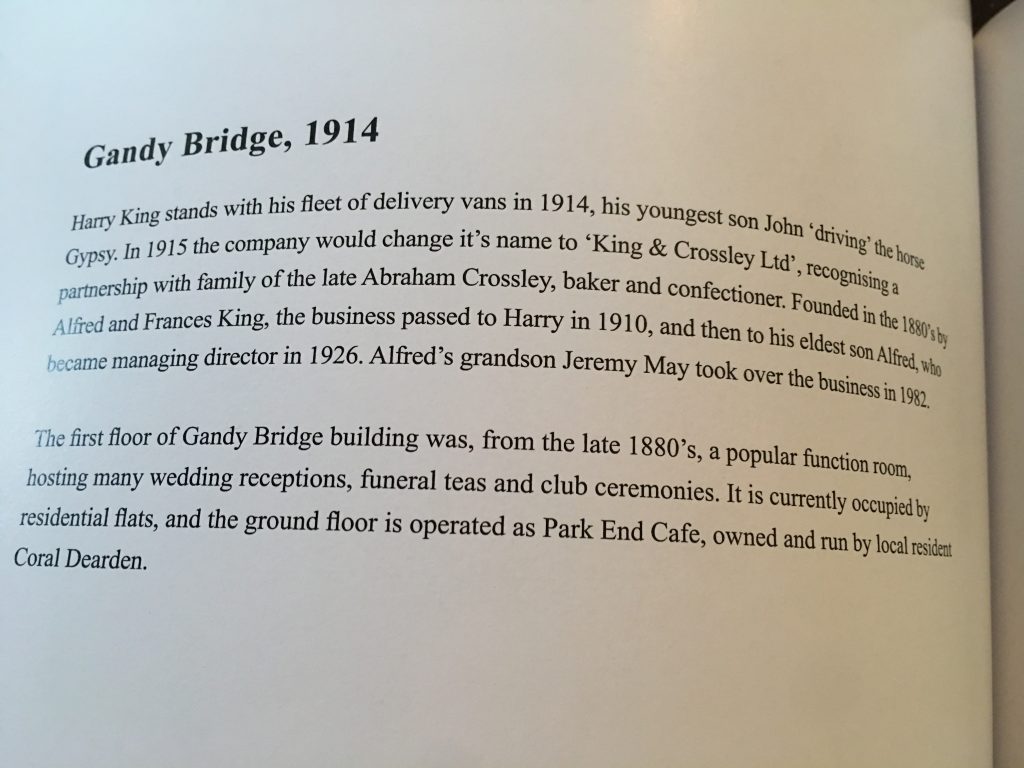
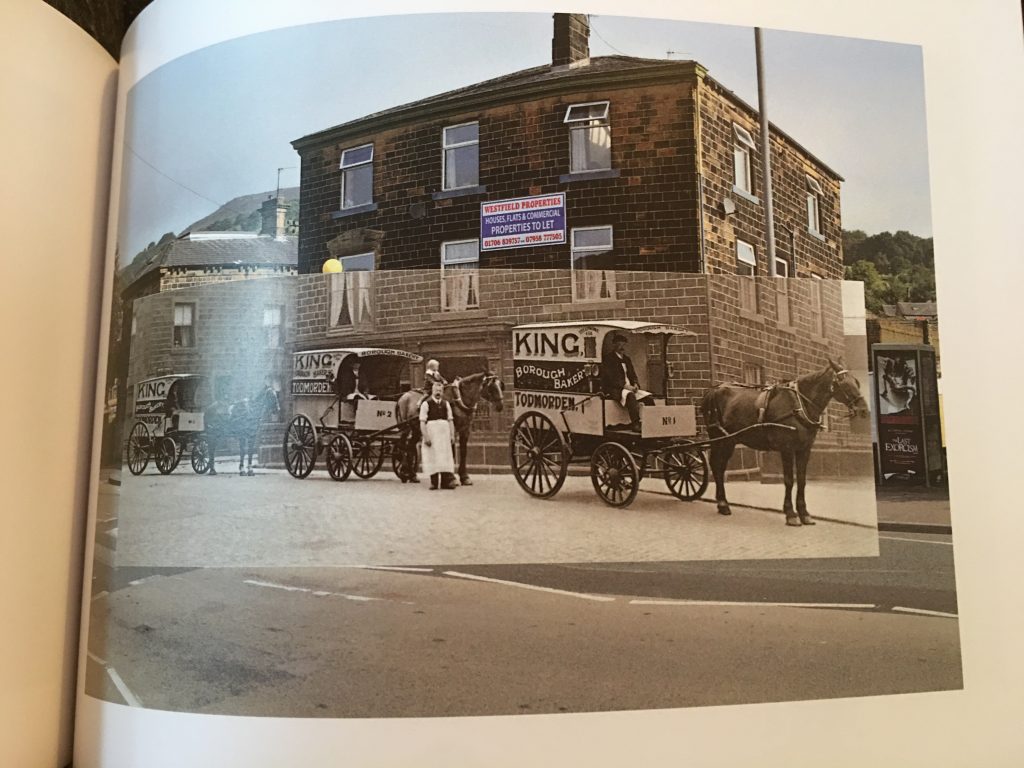
Overlapping the Past and the Present’ is available to buy from Daniel Birch at £5


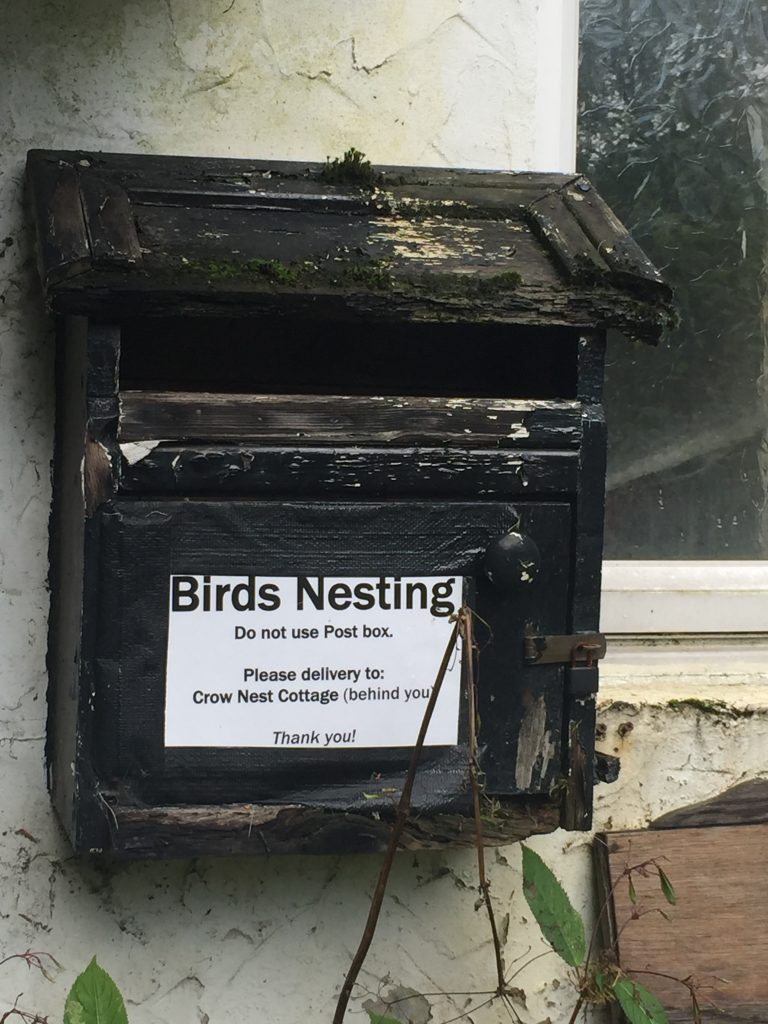
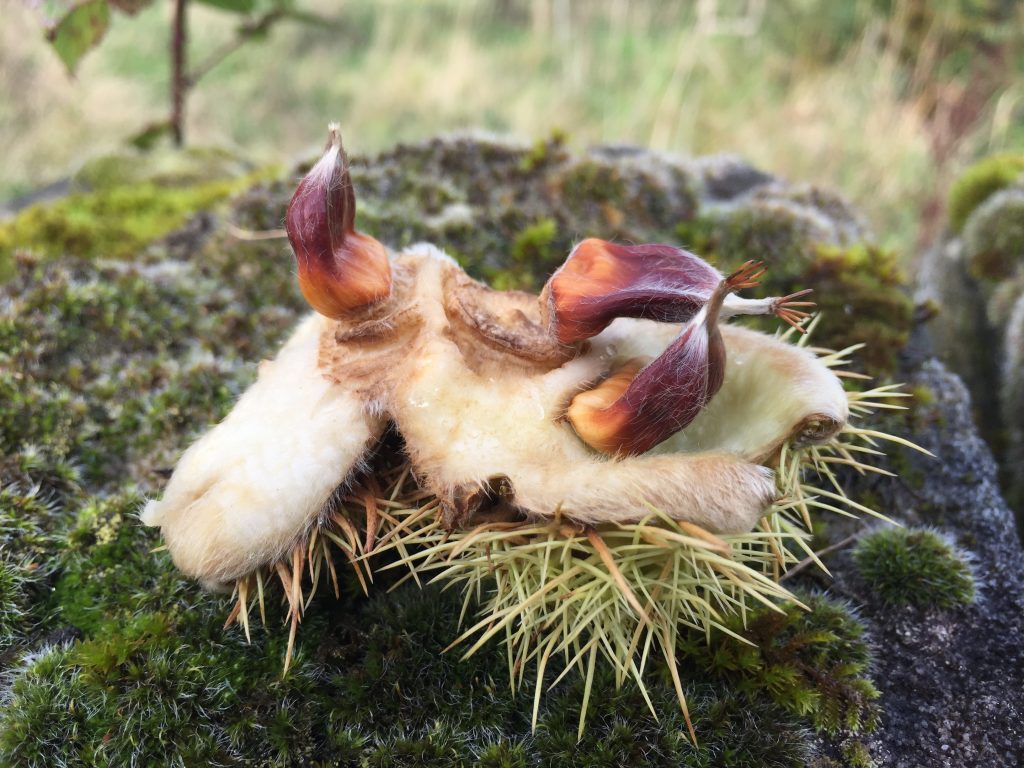

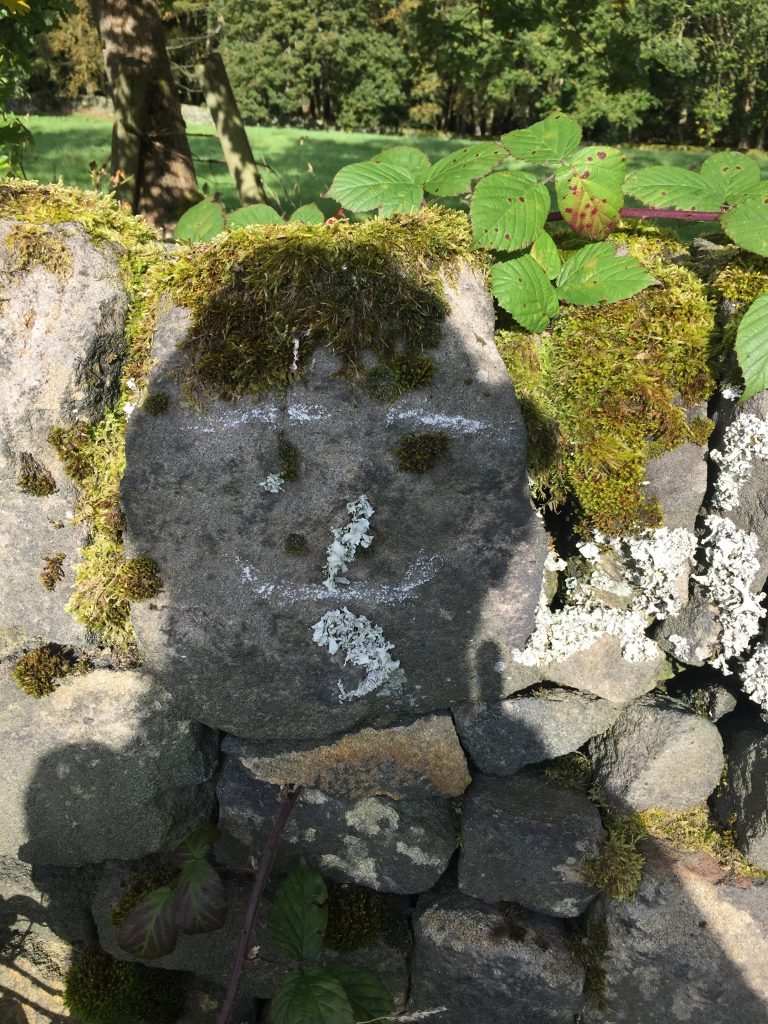
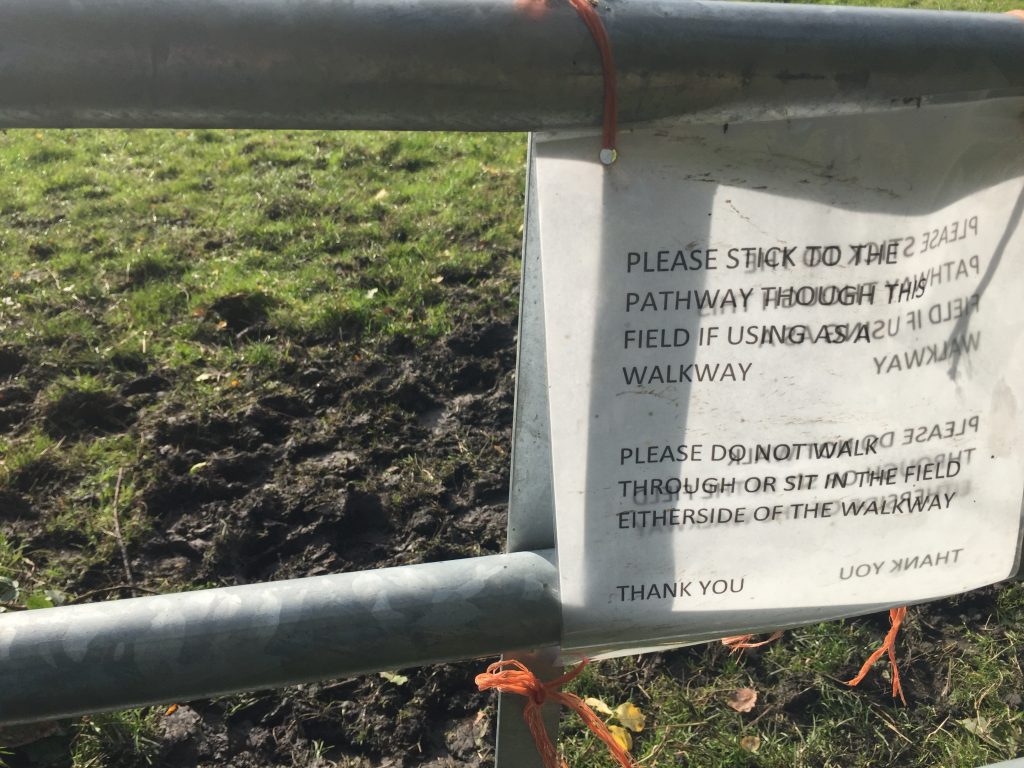


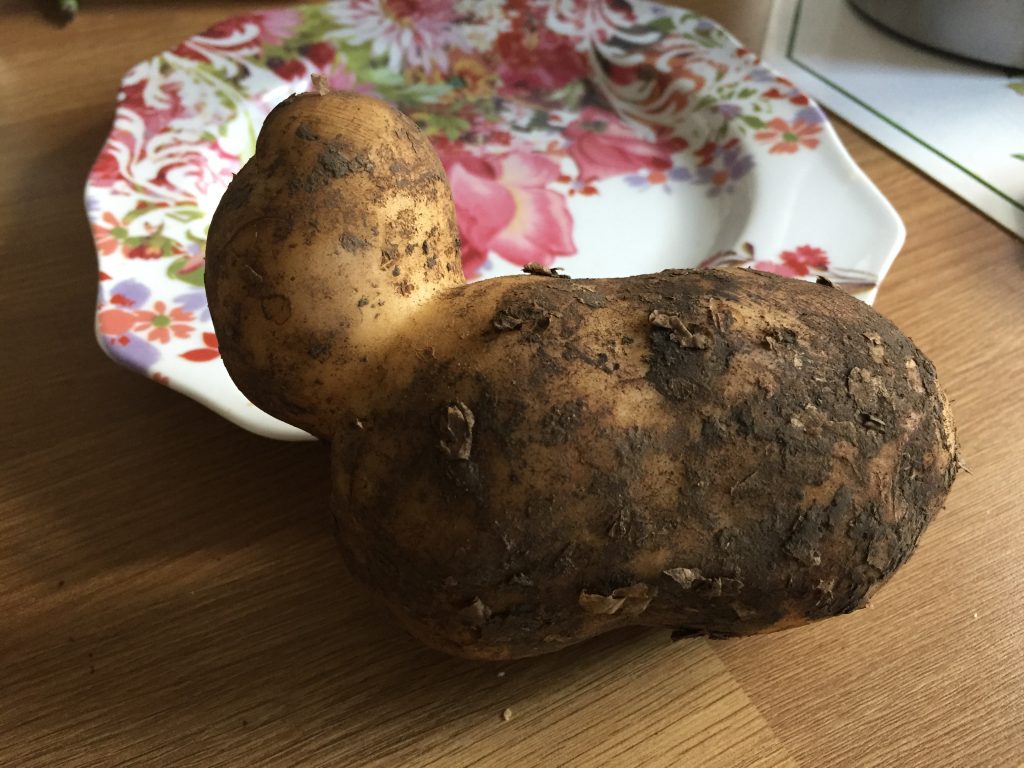

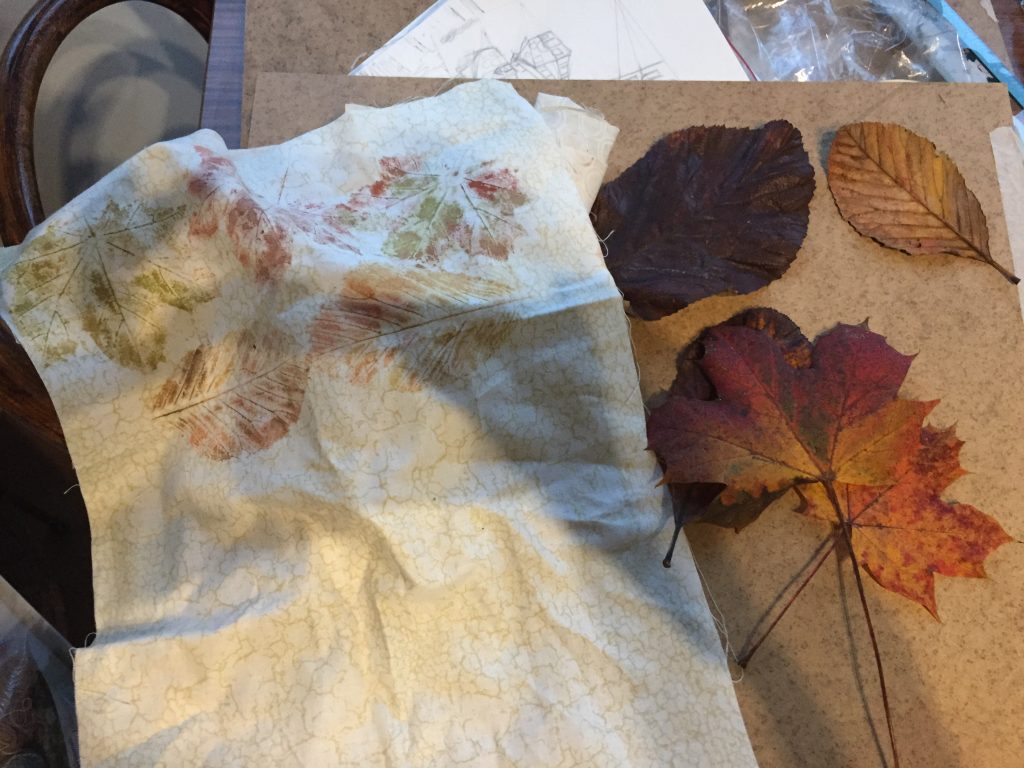
Recent Comments